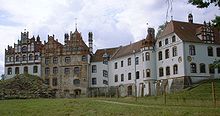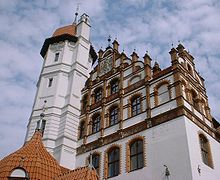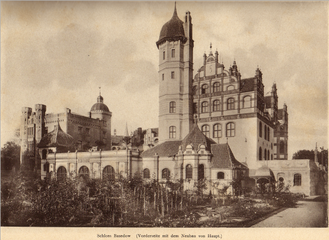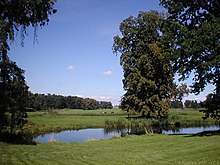Basedow Castle
The Basedow Castle is located in the town of Graves in the district of Mecklenburg Lake District in Mecklenburg-Vorpommern , right on Lake Malchin . It is one of the most important castle complexes in Mecklenburg-Western Pomerania and is now an irregular three-wing complex with a surrounding landscape park with a total area of approx. 200 hectares .
Building history
Previous buildings
The Hahn family , who had lived in Basedow since the 13th century , settled here in 1467 under Knight Lüdeke III. Hahn build a castle with a main tower, walls, moats, outer bailey with two towers, vaults, armory and archive on the remains of a previous castle. Basedow is one of the oldest manor complexes in Mecklenburg. From 1552 the castle was redesigned in several stages in the Renaissance style into a three-storey mansion (preserved as a central wing and stair tower). In the 17th century a new two-storey wing was built, partially stuccoed in the 18th century .
Structural redesign of the castle by Stüler
From 1837 to 1839, under Friedrich Graf von Hahn , this mansion was redesigned according to plans by the Berlin architect Friedrich August Stüler - in the following years also part of the commercial and residential buildings in the town. The north wing of the castle and the terraces (1837–1839) were built according to his plans (burned down in 1891 and rebuilt in 1892–95), as well as a neo-Gothic gatehouse (1837/38; destroyed 1945), the classicist four-wing stables (1835–38) and the country house (1842). In 1844 a neo-Gothic farm building was built on the driveway.
- Basedow Castle after redesign by Stüler
The east wing was built between 1891 and 1895 according to plans by the architect Albrecht Haupt from Hanover in the so-called Johann Albrecht style (a Mecklenburg neo-Renaissance style , characterized in particular by red terracottas in contrast to light plaster ), to which the other palace wings were also adapted.
- Basedow Castle after reconstruction by Haupt
The numerous terracotta medallions on the facade, which show different heads, are particularly striking. The origin of the medallions is unknown; they are probably casts of Italian models. The façade of the portal of the east wing to the courtyard, which is no longer accessible today, is particularly ornate, as a brick building with innumerable decorative elements made of sandstone. The east wing originally also had a sweeping flight of stairs to the southeast to the landscape park.
- Partial views
Lenné park
The Royal Prussian garden designer Peter Joseph Lenne made parallel to and in cooperation with Stüler from 1835 to 1840 several reorganization plans for the Park, according to which from 1835 to 1852 the castle park train to train in the style of an English landscape garden with lock close up flower garden (so. Pleasure Ground ) Groups of beech and oak trees as well as a belt walk along the outer border were created. At least some of the moats in the park still belong to the medieval fortifications. According to the intentions of its planner, the park opens up through visual relationships into the free, agriculturally used landscape of the property (connection of the beautiful with the useful in the sense of an “ ornamented farm ”, ie a “ decorated estate”). Lenné also planned to include the village of Basedow. He integrated existing structures, such as the remains of the castle complex or dolmen graves (large stone graves) of the spherical amphora culture , into the overall planning.
The design of the Basedow landscape is one of Lenné's main works outside of Potsdam due to its all-encompassing planning and cohesion. Basedow is also noted on a laurel wreath that Lenné posthumously venerated on his 50th anniversary in service.
In the park there is a memorial stone for Friedrich Franz Graf von Hahn (born February 5, 1921 in Rostock ; died December 11, 1941 near Taganrog ) with the inscription: The memory of our dear only son. He was the last offspring of the Hahn-Basedow family .
post war period
In a fire in the winter of 1944/45, the gatehouse of the castle, in which the Hahn family archive was located, was destroyed along with the documents. When the Red Army marched in in 1945, the count's family fled and the castle was looted. After 1945, when refugee families from the east were quartered, over 100 people lived in the castle. In 1946 the land reform was carried out and in 1960 an LPG was founded.
The mansion itself is already since 1951 under monument protection . Nevertheless, in the 1970s, the outside staircase leading to the southeast was demolished. The castle, the park, the village and the surrounding landscape have been listed as an ensemble since 1985. From 1988 the park was largely reconstructed in terms of garden conservation by the landscape architect Stefan Pulkenat according to Lenné's plans . In 1996 the facade of the castle was restored, the castle was divided into several apartments and rented out. In September 2000 the castle in need of renovation was sold to a businessman from West Germany, auctioned again in spring 2004 to two Swiss investors and is currently being restored. Some of the castle rooms can be viewed on a guided tour, which also includes the exterior.
The descendants of the Hahn family from a branch of the family, Count Anette and Count Eckhard Hahn von Burgsdorff, founded the “Förderverein Geschmücktes Landgut Basedow eV” to maintain the castle park ensemble.
In the meantime, Basedow Castle, various other buildings and large parts of the castle park have been sold by the community to private owners. A steakhouse restaurant was opened in one of the former farm buildings at the castle.
The opening event for the state of Mecklenburg-Western Pomerania took place in the Basedower Park on the Open Monument Day 2006 (subject of "Historical Gardens").
literature
- Literature about Schloss Basedow in the state bibliography MV (Schloss)
- Literature about Basedow Castle in the State Bibliography MV (Park)
- Literature about Castle and Park Basedow in the GBV union catalog
Individual evidence
- ↑ Count Eckhard Hahn von Burgsdorff is not a direct descendant of the last Count von Hahn on Basedow! (See update of the family tree in the old Sheepfold Basedow.)
- ^ Farmer Steakhouse Basedow
Web links
- Literature about Schloss Basedow in the state bibliography MV
- Basedow Castle and Park (Palaces & Gardens MV)
- Park of Basedow Castle (Kulturportal MV)
- Basedow municipality on the official website
- gutshaeuser.de
- Search for Basedow " in the German Digital Library
- Search for "Schloss, Basedow" in the SPK digital portal of the Prussian Cultural Heritage Foundation
Coordinates: 53 ° 41 ′ 52 " N , 12 ° 40 ′ 56" E
















